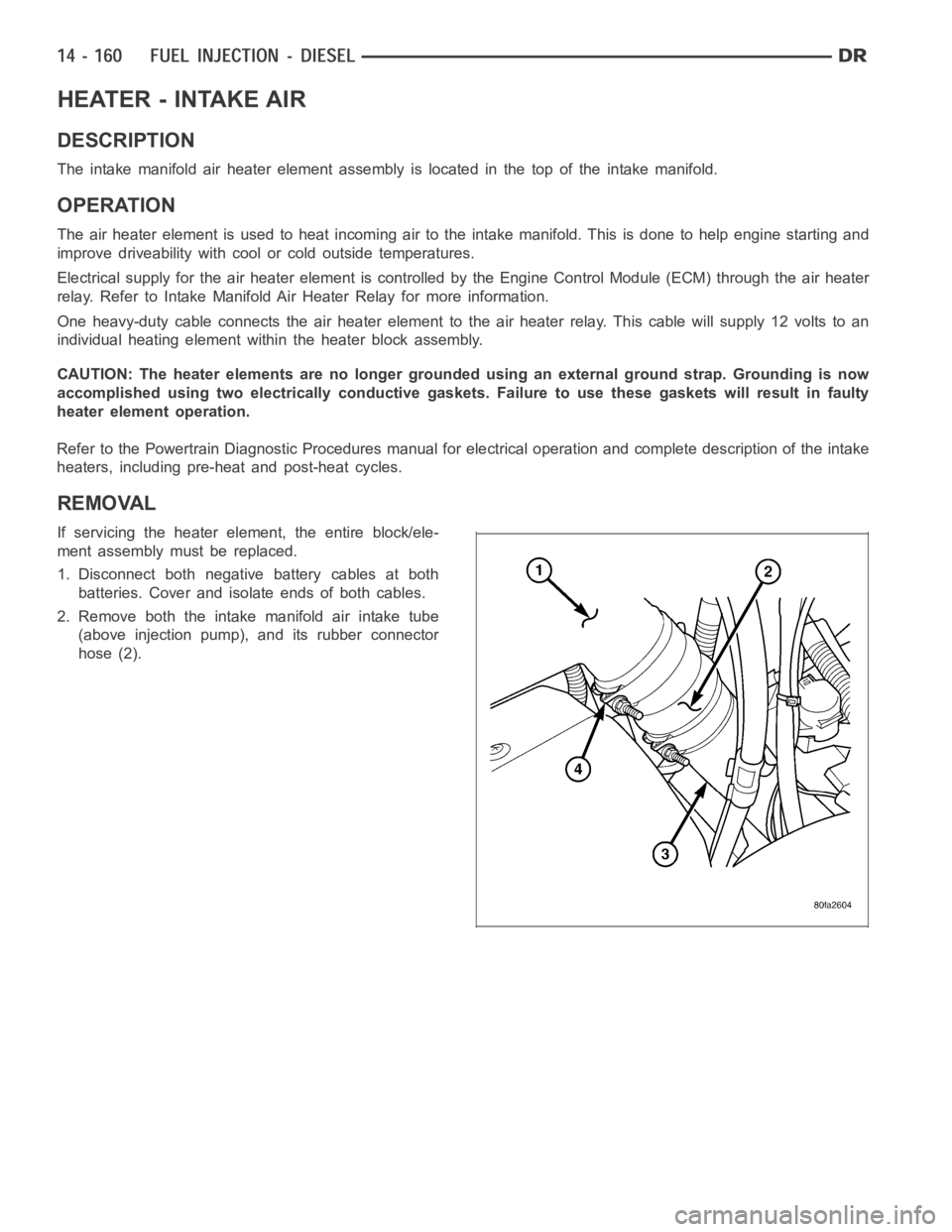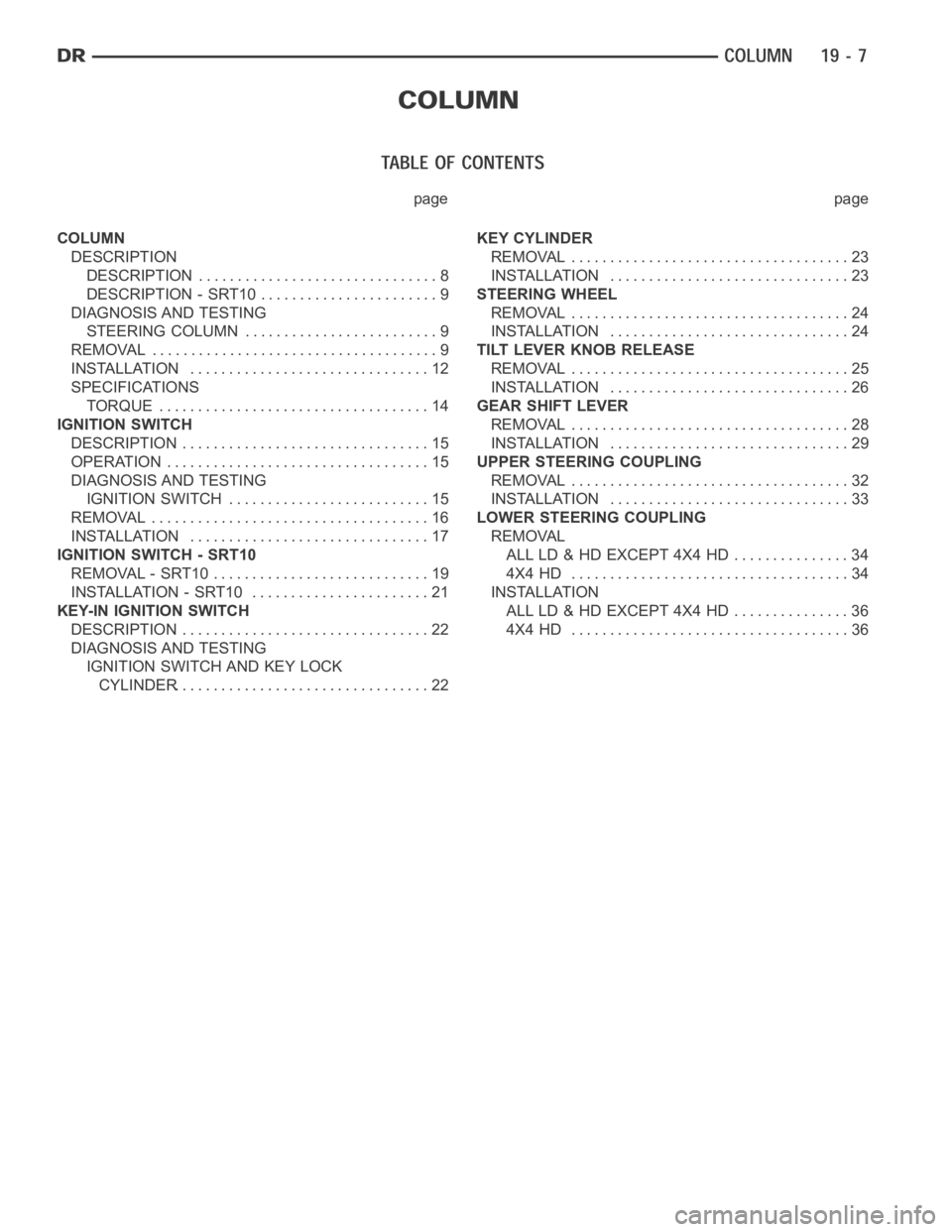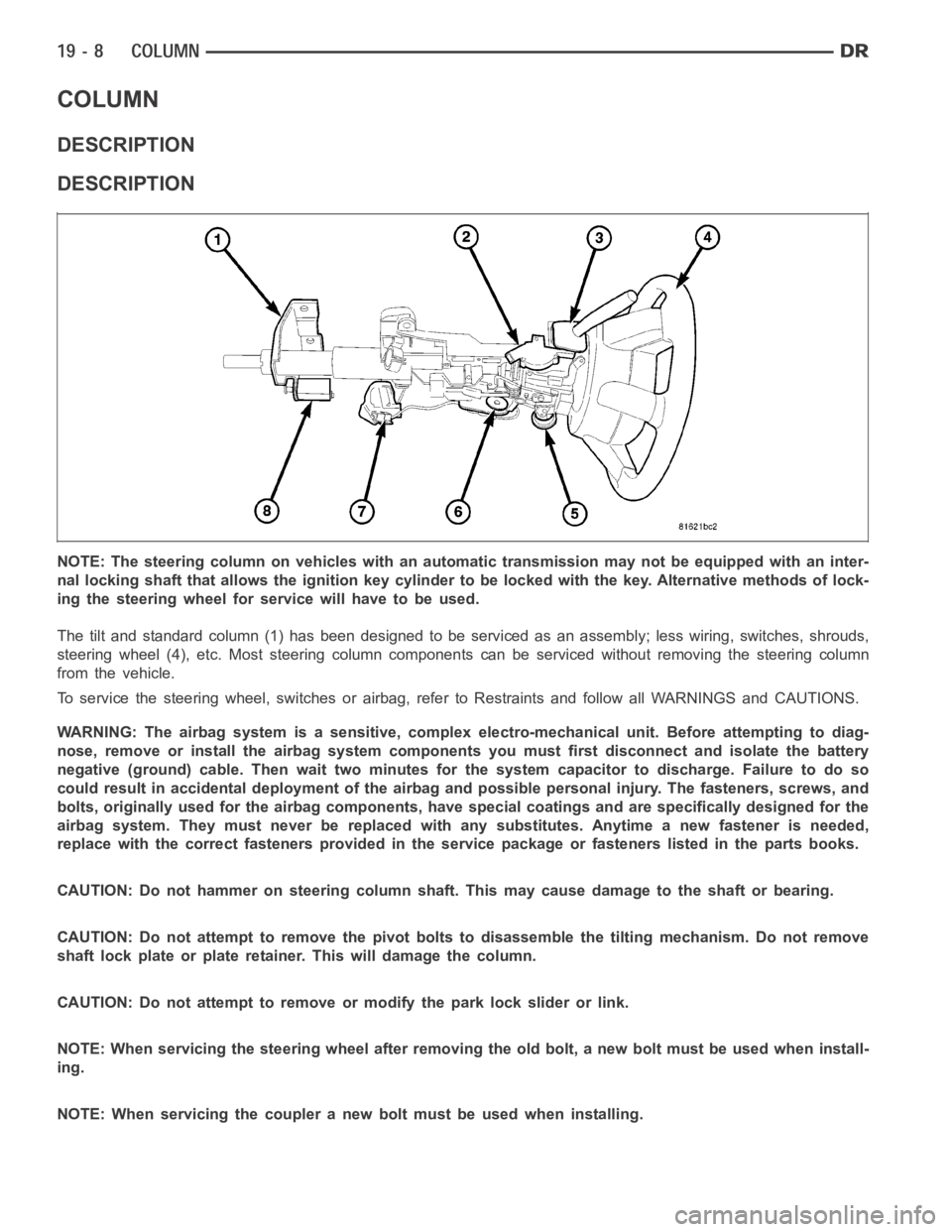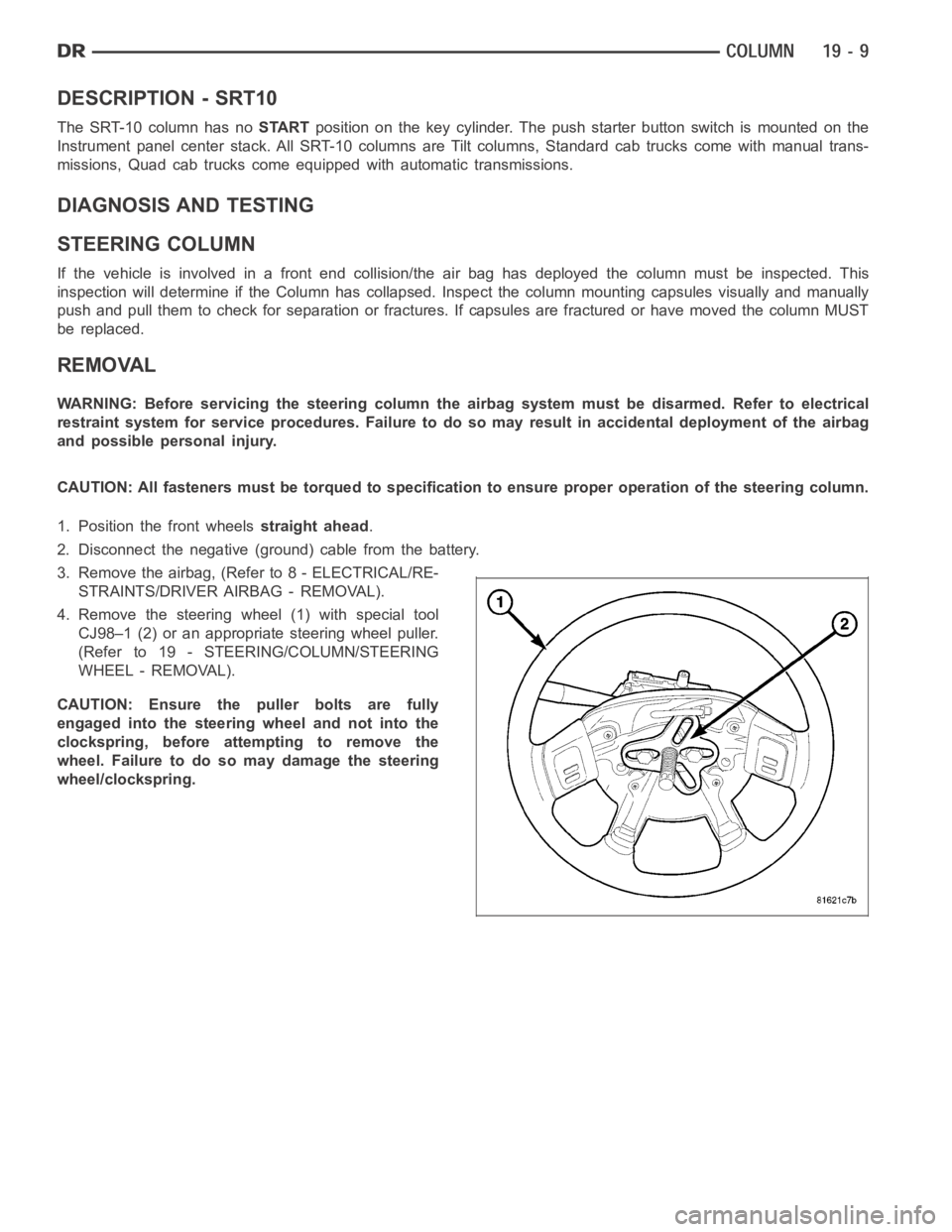Page 2389 of 5267

11. Remove 2 fuel injector hold-down clamp bolts (1)
at each injector being removed.
12. Remove necessary exhaust rocker arm
assembly(s).
13.USING TOOL #9010:
a. Special Tool #9010 is equipped with 2 clam-
shell clamps, a sliding retainer sleeve to retain
the clamshell clamps, a 2–piece mounting
stud, and a pivoting handle.Do not attempt to
remove the fuel injector with any other
device. Damage to injector will occur.
b. The rocker housing is bolted to the top of cyl-
inder head. The mounting stud from tool #9010
was meant to temporarily replace a rocker
housing mounting bolt. Remove the necessary
rocker housing mounting bolt. These mounting
bolts are located at the center of each of the 5
rocker housing support bridges.
c. Install and tighten 2–piece mounting stud to rocker housing. If removing the No. 6 fuel injector, separate the
2–piece mounting stud. Install lower half of mounting stud to center of rocker housing bridge. Install upper
half of mounting stud to lower half.
d. Position tool handle to mounting stud and install handle nut. Leave handle nut loose to allow a pivoting
action.
e. Position lower part of clamshell halves to sides of fuel injector (widershoulder to bottom). The upper part of
clamshell halves should also be positioned into machined shoulder on the handles pivoting head.
f. Slide the retainer sleeve over pivoting handle head to lock clamshell halves together.
g. Be sure handle pivot nut is loose.
h. Depress handle downward to remove fuel injector straight up from cylinder head bore.
Page 2397 of 5267

HEATER - INTAKE AIR
DESCRIPTION
The intake manifold air heater element assembly is located in the top of theintake manifold.
OPERATION
The air heater element is used to heat incoming air to the intake manifold. This is done to help engine starting and
improve driveability with cool or cold outside temperatures.
Electrical supply for the air heater element is controlled by the Engine Control Module (ECM) through the air heater
relay. Refer to Intake Manifold Air Heater Relay for more information.
One heavy-duty cable connects the air heater element to the air heater relay. This cable will supply 12 volts to an
individual heating element within the heater block assembly.
CAUTION: The heater elements are no longer grounded using an external ground strap. Grounding is now
accomplished using two electrically conductive gaskets. Failure to use these gaskets will result in faulty
heater element operation.
Refer to the Powertrain Diagnostic Procedures manual for electrical operation and complete description of the intake
heaters, including pre-heat and post-heat cycles.
REMOVAL
If servicing the heater element, the entire block/ele-
ment assembly must be replaced.
1. Disconnect both negative battery cables at both
batteries. Cover and isolate ends of both cables.
2. Remove both the intake manifold air intake tube
(above injection pump), and its rubber connector
hose (2).
Page 2399 of 5267
INSTALLATION
If servicing the heater element, the entire block/ele-
ment assembly must be replaced.
CAUTION: The heater elements are no longer
grounded using an external ground strap. Ground-
ing is now accomplished using two electrically
conductive gaskets. Failure to use these gaskets
will result in faulty heater element operation.
1. Using 2 new gaskets, position element assembly
and air housing to intake manifold (2).
2. Install wire harness clips to intake connection stud.
3. Install 4 housing bolts (1) and tighten to 24 Nꞏm
(18 ft. lbs.) torque.
4. Connect 2 positive (+) heater cables (6) at cable
mounting studs.Do not allow either of the cable
eyelets to contact any other metal source other
than the cable nuts/studs.
5. Install engine oil dipstick tube and mounting bolt
(5).
6. Connect rubber connector hose and intake tube to
air intake housing. Tighten clamp bolts to 11 Nꞏm
(100 in. lbs.) torque.
7. Connect both negative battery cables at both
batteries.
Page 2412 of 5267

page page
COLUMN
DESCRIPTION
DESCRIPTION ............................... 8
DESCRIPTION - SRT10 ....................... 9
DIAGNOSIS AND TESTING
STEERING COLUMN ......................... 9
REMOVAL ..................................... 9
INSTALLATION ............................... 12
SPECIFICATIONS
TORQUE ................................... 14
IGNITION SWITCH
DESCRIPTION ................................ 15
OPERATION .................................. 15
DIAGNOSIS AND TESTING
IGNITION SWITCH .......................... 15
REMOVAL .................................... 16
INSTALLATION ............................... 17
IGNITION SWITCH - SRT10
REMOVAL - SRT10 ............................ 19
INSTALLATION - SRT10 ....................... 21
KEY-IN IGNITION SWITCH
DESCRIPTION ................................ 22
DIAGNOSIS AND TESTING
IGNITION SWITCH AND KEY LOCK
CYLINDER................................. 22KEY CYLINDER
REMOVAL .................................... 23
INSTALLATION ............................... 23
STEERING WHEEL
REMOVAL .................................... 24
INSTALLATION ............................... 24
TILT LEVER KNOB RELEASE
REMOVAL .................................... 25
INSTALLATION ............................... 26
GEAR SHIFT LEVER
REMOVAL .................................... 28
INSTALLATION ............................... 29
UPPER STEERING COUPLING
REMOVAL .................................... 32
INSTALLATION ............................... 33
LOWER STEERING COUPLING
REMOVAL
ALL LD & HD EXCEPT 4X4 HD ............... 34
4X4 HD .................................... 34
INSTALLATION
ALL LD & HD EXCEPT 4X4 HD ............... 36
4X4 HD .................................... 36
Page 2413 of 5267

COLUMN
DESCRIPTION
DESCRIPTION
NOTE: The steering column on vehicles with an automatic transmission may not be equipped with an inter-
nal locking shaft that allows the ignition key cylinder to be locked with the key. Alternative methods of lock-
ing the steering wheel for service will have to be used.
The tilt and standard column (1) has been designed to be serviced as an assembly; less wiring, switches, shrouds,
steering wheel (4), etc. Most steering column components can be serviced without removing the steering column
from the vehicle.
To service the steering wheel, switches or airbag, refer to Restraints andfollow all WARNINGS and CAUTIONS.
WARNING: The airbag system is a sensitive, complex electro-mechanical unit. Before attempting to diag-
nose, remove or install the airbag system components you must first disconnect and isolate the battery
negative (ground) cable. Then wait two minutes for the system capacitor todischarge. Failure to do so
could result in accidental deployment of the airbag and possible personalinjury. The fasteners, screws, and
bolts, originally used for the airbag components, have special coatings and are specifically designed for the
airbag system. They must never be replaced with any substitutes. Anytime anew fastener is needed,
replace with the correct fasteners provided in the service package or fasteners listed in the parts books.
CAUTION: Do not hammer on steering column shaft. This may cause damage to the shaft or bearing.
CAUTION: Do not attempt to remove the pivot bolts to disassemble the tilting mechanism. Do not remove
shaft lock plate or plate retainer. This will damage the column.
CAUTION: Do not attempt to remove or modify the park lock slider or link.
NOTE: When servicing the steering wheel after removing the old bolt, a new bolt must be used when install-
ing.
NOTE: When servicing the coupler a new bolt must be used when installing.
Page 2414 of 5267

DESCRIPTION - SRT10
The SRT-10 column has noSTARTposition on the key cylinder. The push starter button switch is mounted on the
Instrument panel center stack. All SRT-10 columns are Tilt columns, Standard cab trucks come with manual trans-
missions, Quad cab trucks come equipped with automatic transmissions.
DIAGNOSIS AND TESTING
STEERING COLUMN
If the vehicle is involved in a front end collision/the air bag has deployedthe column must be inspected. This
inspection will determine if the Column has collapsed. Inspect the columnmounting capsules visually and manually
push and pull them to check for separation or fractures. If capsules are fractured or have moved the column MUST
be replaced.
REMOVAL
WARNING: Before servicing the steering column the airbag system must be disarmed. Refer to electrical
restraint system for service procedures. Failure to do so may result in accidental deployment of the airbag
and possible personal injury.
CAUTION: All fasteners must be torqued to specification to ensure proper operation of the steering column.
1. Position the front wheelsstraight ahead.
2. Disconnect the negative (ground) cable from the battery.
3. Remove the airbag, (Refer to 8 - ELECTRICAL/RE-
STRAINTS/DRIVER AIRBAG - REMOVAL).
4. Remove the steering wheel (1) with special tool
CJ98–1 (2) or an appropriate steering wheel puller.
(Refer to 19 - STEERING/COLUMN/STEERING
WHEEL - REMOVAL).
CAUTION: Ensure the puller bolts are fully
engaged into the steering wheel and not into the
clockspring, before attempting to remove the
wheel. Failure to do so may damage the steering
wheel/clockspring.
Page 2415 of 5267
5. Remove the kneeblocker (2) and the steering col-
umn opening cover (1) (Refer to 23 - BODY/IN-
STRUMENT PANEL/STEERING COLUMN
OPENING COVER - REMOVAL).
6. Remove the screw (1) securing the tilt lever knob
(2).
7. Remove the column shrouds (1&2).
Page 2416 of 5267
8. Remove the clock spring, (Refer to 8 - ELECTRI-
CAL/RESTRAINTS/CLOCKSPRING - REMOVAL).
9. Disconnect the wiring harness (8) to the column.
10. Remove the shift cable (5) from the column shift
lever actuator (4) (Refer to 21 - TRANSMISSION/
TRANSAXLE/AUTOMATIC - 32RH/GEAR SHIFT
CABLE - REMOVAL).
11. Release the shift cable (5) from the column
bracket (7) and remove it from the bracket.
12. Remove the upper steering shaft coupler bolt (2).
13. Separate the shaft from the coupler (3).
14. Remove the brake light switch (2) and discard
(Refer to 8 - ELECTRICAL/LAMPS/LIGHTING -
EXTERIOR/BRAKE LAMP SWITCH - REMOVAL).
15. Remove the four steering column mounting nuts
(1 & 3).